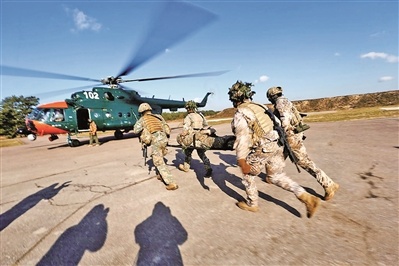
American media reported that NATO’s many conflicts have come to the fore with the spread of the COVID-19 pandemic and its widely criticized response, exposing the already wobbling alliance to greater tests in the future.
NATO’s pandemic response is widely criticized.
An article published on America’s War on the Rocks website showed that all NATO members have been seriously hit by the COVID-19 outbreak with those in Europe once becoming the “epicenter”, yet the organization’s response so far has been nothing but disappointing.
NATO hasn’t taken strong prevention and control measures. Although NATO has taken some pandemic containment measures, its Euro-Atlantic Disaster Response Coordination Centre (EADRCC), in general, hasn’t played its due role of organizing, leading and coordinating the efforts. The member states are mostly on their own fighting the novel coronavirus and a coordinated prevention and control network hasn’t been formed.
NATO’s war-preparedness activities are affected. Lately, Gen. Tod Wolters, NATO’s Supreme Allied Commander Europe, and the U.S. European Command claimed that the alliance’s war-preparedness hasn’t been affected by the pandemic, but the reality is that NATO has decided to call off the winter exercise Cold Response 2020 in Norway. As several NATO members have ramped up containment measures, Exercise Defender-Europe 20, one of the group’s largest exercises since the Cold War, has also been put on hold.
The US is slammed for poor pandemic response. As one of the most important NATO members, the US has been “absent” from the coordinated battle against COVID-19. The American website Defense One published an article titled “Where is NATO? And Where is Trump? ”, which said the Trump administration initially signaled the crisis was not a NATO problem. After the virus spread all over the world, the Trump administration’s silence on NATO’s role has been deafening, “raising doubts among even the administration’s staunchest European friends”.
A lot of problems have come to the fore. According to US media, the NATO’s many other problems have also surfaced in addition to the poor performance in coordinated prevention and control.
The first is the defense spending issue. Foreign media generally believe that some of NATO’s European members will probably cut their national defense budget due to the strain imposed by the pandemic on their economy, making it even harder to meet Trump’s request for a defense budget that accounts for 2% of national GDP. Washington and Brussels are likely to argue more intensely about the sharing of defense expenses, which may undermine NATO’s solidarity and affect American troops in Europe.
The second is war-readiness. So far quite a number of soldiers in Europe-based American troops and the militaries of Lithuania, Norway, and other countries have been infected with COVID-19, and NATO’s joint exercises and training, as well as personnel deployments, are mostly at a halt. NATO’s top priority now is to maintain war-readiness and guarantee troops movement and normal combat operations in extraordinary conditions, according to foreign media.
The third problem is command and control. The website Defense One pointed out that one lesson that NATO can learn from the pandemic is strengthening communication and connection, enhancing the resilience of its command and control system, and realize real-time, efficient communication connecting four-star generals all the way to the rank and file. Furthermore, the building of nuclear combat command and control capabilities becomes more important as the outbreak lends a heavy blow to NATO’s regular combat forces and deterrence.
Last but not least is the production chain of the military industry. The COVID-19 outbreak has shocked the global production chain, not only affecting the production of large battling platforms and ammunition for many NATO members, but also making the acquisition of certain important parts and components more difficult. This will probably slow down NATO’s R&D in AI and other cutting-edge technologies.
The prospects for NATO are gloomy.
Analysts said that the root cause for NATO’s poor response to the outbreak and other problems lies in itself –the military bloc’s unclear positioning and functions, unclear thoughts on development, and inefficient internal operation since the end of the Cold War, particularly since Donald Trump took office in 2017. Foreign media commented that a political-military alliance that’s believed to be “brain dead” can hardly deal with a significant public health emergency like the COVID-19 pandemic effectively, much less the real threats and potential crisis facing its member states.
As the US keeps making trouble, the pandemic continues to wreak havoc and other challenges keep escalated, the prospect for NATO is gloomy.
For one thing, the divide between the US and Europe will grow wider. The Trump administration may continue to promote its “America first” policy and pressure NATO’s European members on the sharing of defense expenses and other issues. Its tough stance will encounter fierce discontent and open opposition from relevant countries, driving the two sides further apart from each other.
For another, NATO’s transformation process is strewn with obstacles. The poor coordination in battling the novel coronavirus has prompted a rising call within NATO for military transformation. Generally speaking, the alliance’s military system has many weak links in its command and control, maintenance of war-readiness, maneuvering and logistics, with extremely unbalanced military strength among the member states as well. However, its military transformation, which involves too many aspects and faces too many obstacles, isn’t likely to enjoy a plain sailing and make substantial progress.
At last, self-affirmation is a long and hard journey for NATO. As an outcome of the Cold War, the value of NATO’s presence is being increasingly questioned. To affirm itself, the alliance, on the one hand, has to get the US onto the “right track” and, on the other hand, further cement the consensus among member states in development direction and measures. It will be an extremely arduous task, one that NATO cannot shy away from but is almost impossible to accomplish.













